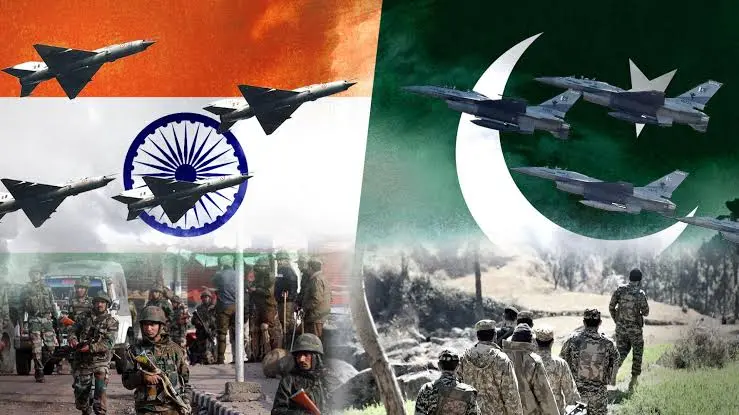Introduction
The longstanding geopolitical rivalry between Pakistan and India has once again erupted into open hostility, with recent events underscoring the fragility of peace in South Asia. This blog delves into the latest escalation, focusing on Pakistan’s defensive response to Indian aggression, the tragic civilian casualties, and the broader implications of attacks on critical infrastructure like the Neelum-Jhelum Power Project. We also explore historical grievances, including the Kashmir dispute, Balochistan conspiracy theories, and Pakistan’s unprecedented military achievement involving the Rafale aircraft.
Table of Contents
The Trigger – Indian Aggression and Pakistan’s Defensive Response
On the night of [insert date], Indian forces launched what Pakistani authorities describe as an unprovoked act of Indian aggression, targeting multiple locations across Pakistan-administered territories. According to the Inter-Services Public Relations (ISPR), Pakistan’s military responded with a calculated defensive response, emphasizing that this retaliation was limited to neutralizing immediate threats.
Lieutenant General Ahmed Sharif Chaudhry, Director General of ISPR, stated:
“Pakistan exercised restraint but demonstrated resolve. Our actions were purely defensive, aimed at protecting our sovereignty. However, the matter of holding India accountable for its aggression remains unresolved.”
The strikes reportedly focused on Indian military installations near the border, but the fallout extended far beyond, with civilian casualties and infrastructure damage dominating headlines.
Civilian Casualties – The Human Cost of Conflict
The human toll of this escalation has been devastating. According to ISPR reports, Indian aggression resulted in 26 civilian martyrs and 46 injured across six locations. Among the dead were women and children, including two 3-year-old girls in Ahmedpur East.
Breakdown of Attacks:
- Ahmedpur East, Bahawalpur:
- Target: Subhan Allah Mosque and residential quarters.
- Impact: 13 martyred, including 7 women and 4 men; 31 injured.
- Damage: Mosque destroyed, adjacent homes damaged.
- Muzaffarabad:
- Target: Bilal Mosque.
- Impact: 3 martyred, 1 child injured.
- Kotli:
- Target: Ibadat Mosque.
- Impact: 2 teenagers martyred, 2 women injured.
The deliberate targeting of mosques—a recurring theme in this conflict- has drawn condemnation from global human rights organizations. These attacks not only violate international humanitarian law but also deepen communal fractures.
Infrastructure Under Fire – The Neelum-Jhelum Power Project
One of the most alarming aspects of Indian aggression was the damage inflicted on the Neelum-Jhelum Power Project, a $5 billion hydroelectric facility critical to Pakistan’s energy grid. Located in Azad Kashmir, the project has long been a flashpoint, with India disputing its legality under the Indus Waters Treaty.
Why This Matters:
- Energy Security: The project generates 969 MW of electricity, powering millions of homes.
- Economic Implications: Sabotage disrupts Pakistan’s efforts to combat energy shortages, worsening economic instability.
- Environmental Risks: Damage to hydro infrastructure could trigger ecological disasters in the Himalayan region.
Pakistani engineers are racing to assess the damage, but repairs could take months, further straining the nation’s resources.
The Balochistan Conspiracy – A Historical Context
Amidst the chaos, Pakistani officials have revived discussions about the Balochistan conspiracy—a theory alleging foreign involvement in destabilizing the province. While India denies these claims, Pakistan insists that external actors, including India, have historically supported separatist movements.
Key Points:
- 2010 Timeline: Leaked documents in the past suggested plots to Balkanize Pakistan by 2010, with Balochistan as a focal point.
- Current Relevance: The recent conflict has reignited fears of covert operations aimed at weakening Pakistan’s territorial integrity.
ISPR’s statement reflects this anxiety:
“India’s aggression is not isolated. It’s part of a broader design to undermine Pakistan’s stability, from Kashmir to Balochistan.”
Amidst the chaos, Pakistani officials have revived discussions about the Balochistan conspiracy—a theory alleging foreign involvement in destabilizing the province. While India denies these claims, Pakistan insists that external actors, including India, have historically supported separatist movements.
Key Points:
- 2010 Timeline: Leaked documents in the past suggested plots to Balkanize Pakistan by 2010, with Balochistan as a focal point.
- Current Relevance: The recent conflict has reignited fears of covert operations aimed at weakening Pakistan’s territorial integrity.
ISPR’s statement reflects this anxiety:
“India’s aggression is not isolated. It’s part of a broader design to undermine Pakistan’s stability, from Kashmir to Balochistan.”
Kashmir Dispute – The Unfinished Agenda of Partition
No discussion of Pakistan-India tensions is complete without addressing the Kashmir dispute. Since 1947, Kashmir has remained a nuclear tinderbox, with both nations claiming the region in full.
UN Resolution & Broken Promises:
- 1948 UN Resolution: Mandated a plebiscite for Kashmiris to determine their fate.
- India’s Stance: Rejects third-party mediation, labeling Kashmir an “internal matter.”
- Pakistan’s Position: Advocates for international intervention to implement the referendum.
The recent violence has further marginalized hopes for dialogue, with Pakistan accusing India of using brute force to silence Kashmiri dissent.
Pakistan Air Force’s Historic Feat – The Rafale Aircraft Downing
In a dramatic turn, the Pakistan Air Force (PAF) announced a historic milestone: becoming the first air force globally to shoot down a French-made Rafale aircraft, a jewel in India’s military arsenal.
Significance of the Rafale:
- Advanced Capabilities: The Rafale is a 4.5-generation multirole fighter jet prized for its agility and stealth.
- Symbolic Victory: Neutralizing this aircraft shatters the myth of its invincibility, boosting Pakistani morale.
While India has not officially confirmed the loss, the PAF’s claim has sparked debates about evolving aerial combat dynamics in South Asia.
International Apathy and the Role of Global Institutions
Pakistan’s frustration with the UN resolution on Kashmir mirrors its broader disillusionment with international bodies. Critics argue that organizations like the UN disproportionately favor powerful states, leaving conflicts like Kashmir in limbo.
Case in Point:
- Water Dispute: Pakistan accuses India of weaponizing water-sharing agreements, exacerbating agricultural crises in Punjab and Sindh.
- Double Standards: Despite resolutions, the UN’s inaction on Kashmir contrasts sharply with its interventions elsewhere.
Emergency Alert – Preparing for the Worst
As tensions escalate, Pakistani authorities issued an emergency alert urging citizens in border regions (Sahiwal, Okara, Sialkot) to seek shelter. Social media advisories emphasize:
- Avoiding rumors.
- Securing children and the elderly.
- Heeding military directives.
The alert follows reports of Indian warplanes mobilizing near the Sulemanki border, hinting at a potential large-scale offensive.
Conclusion: A Call for Restraint and Global Attention
The latest Pakistan-India tensions are a stark reminder of how quickly historical grievances can spiral into catastrophe. With civilian casualties mounting, critical infrastructure like the Neelum-Jhelum Power Project damaged, and the specter of the Balochistan conspiracy looming, the need for diplomatic intervention is urgent.
Pakistan’s defensive response underscores its commitment to sovereignty, but the path to peace requires addressing root causes: implementing the UN resolution on Kashmir, halting Indian aggression, and fostering regional cooperation. As the world watches, South Asia stands at a crossroads, one that demands wisdom, not warfare.
Frequently Asked Questions
- What triggered the recent Pakistan-India conflict?
India launched strikes targeting Pakistani territories, prompting Pakistan’s defensive retaliation. Civilian casualties and infrastructure damage followed. - How many civilians were killed or injured?
Pakistani authorities reported 26 civilian deaths and 46 injured, including women and children, in attacks on mosques and residential areas. - What is the Neelum-Jhelum Power Project, and why was it targeted?
A critical $5 billion hydropower facility in Azad Kashmir, it generates 969 MW of electricity. Damage to it risks Pakistan’s energy security and regional ecology. - What is the Balochistan conspiracy theory?
Pakistan alleges foreign actors, including India, supported separatist movements to destabilize Balochistan by 2010—claims India denies. - What is the status of the Kashmir dispute?
A UN-mandated plebiscite remains unimplemented since 1948. India calls Kashmir an internal matter, while Pakistan demands international intervention. - How does the UN factor into this conflict?
Pakistan criticizes the UN for failing to enforce resolutions on Kashmir and address India’s alleged water treaty violations. - What is the significance of Pakistan downing a Rafale aircraft?
The Pakistan Air Force claims it became the first to destroy France’s advanced Rafale jet, challenging India’s air superiority narrative. - What areas are under emergency alert?
Border regions like Sahiwal, Okara, and Sialkot received alerts amid reports of Indian warplane movements. Citizens are urged to seek shelter. - How did Pakistan justify its defensive response?
ISPR stated strikes were limited to countering immediate threats, emphasizing sovereignty protection while vowing future accountability for Indian aggression. - Are tensions likely to escalate further?
With both nations on high alert and historical grievances unresolved, risks of escalation remain high unless diplomatic intervention occurs.

